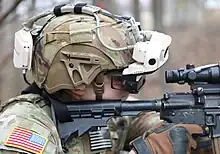Integrated Visual Augmentation System
The Integrated Visual Augmentation System (IVAS) is an augmented reality headset being developed by Microsoft for the United States Army, providing a wide variety of new capabilities to soldiers. Originally developed for infantry, it is also being adapted for use by mounted soldiers and aircrew. Its development was initiated in 2018 and is currently undergoing testing, although numerous problems have repeatedly delayed its deployment in the field.
| Integrated Visual Augmentation System | |
|---|---|
 Soldier dons IVAS 1.2 Prototype during user assessment. | |
| Type | Augmented reality headset |
| Place of origin | United States |
| Production history | |
| Designer | Microsoft |
| Designed | 2018 |
| Specifications | |
| Weight | 3.4 lb (1.5 kg) |
Design
IVAS is an augmented reality system based on the Microsoft Hololens 2 headset.[1] It intends to provide soldiers with "improved situational awareness, target engagement, and informed decision-making". [2]
The system consists of a display, a computer known as a "puck", a networked data radio, and three conformal batteries. The display can augment the soldier's vision with imagery from thermal and low-light imaging sensors. It also contains an internal compass for navigation and can display imagery from the Family of Weapons Sights-Individual mounted on the soldier's weapon. The radio allows data from the soldiers' individual IVAS headsets to be passed among members of the company.[3]
The latest version of IVAS, version 1.2, weighs 3.4 pounds (1.5 kg), although developers are working to reduce this to the target weight of 2.9 pounds (1.3 kg). The computer is attached to the back of the helmet for a "better center of gravity". The display has a field of view of 60 degrees, using a flat display that can be flipped upwards.[4]
History
Although it is unknown when the idea for IVAS was first conceived, the Army Acquisition Executive first approved IVAS's development effort on September 25, 2018, and an Other Transaction Agreement for the development of IVAS was issued to Microsoft in November 2018. Initial testing began in March 2019. [5]
2020
As of October 2020, IVAS was on its third iteration. Previous tests used commercial Microsoft HoloLens 2 headsets which were not resistant to inclement weather. A ruggedized version of the system was tested in late October 2020 at Fort Pickett by some Marines and members of the 82nd Airborne Division. The test was to get soldier feedback and refine the system for eventual battlefield use.[1]
In December 2020, the United States Congress decided to cut $230 million of the $1.1 billion request for the Army's IVAS goggles. It also wanted the US Army to submit a report detailing the acquisition strategy for the IVAS program by 15 August 2021.[6]
2021

After nearly 2 years in development, the final IVAS Capability Set 4 system was scheduled to be fielded in 2021. Over 40,000 sets were planned to be issued.[1]
On March 26, 2021, Microsoft was awarded a "fixed price production agreement" by the United States Army to manufacture and supply IVAS headsets.[7] Microsoft would produce headsets for at least 120,000 members of the Army Close Combat Force.[8] The contract was worth up to US$21.88 billion dollars.[9]
Also in March 2021, the U.S. Army announced that IVAS was being tested with mounted soldiers, such as on Bradley Fighting Vehicle and Stryker teams.[10] By June 2021, the US Army announced it was expanding IVAS tests to include aircrews for helicopters and drones.[11] In comparison to the $400,000 purely-slaved and aircraft-dependent F-35 helmet that must be custom-built for each pilot,[12] IVAS attached to any helmet, was estimated to cost $29,205 per unit, and could optionally work independent of the aircraft when the crew dismounts.[13]
In September 2021 an "Adversarial Electronic Warfare and Cybersecurity Test" of IVAS was conducted.[14] In mid-October, the system's "Operational Test and fielding" was moved to 2022. David Patterson, PEO Soldier Director of Public Affairs, said: "The Army intends to continue developing and fielding this revolutionary, first-of-its-kind technology in FY22."[14]
2022
In March 2022, considering the numerous technical issues the program encountered, Congress withheld approximately $400 million in funding for the program until IVAS completed its initial operation testing and the Program Executive Office Soldier briefed the appropriations committees on the program's progress.[15][16] The testing began in May and concluded in late June, although at the time it was believed that the fielding of IVAS in September was unlikely.[17][18]
In September 2022, the US Army began accepting 5000 units of the IVAS and was planning to field them, even though these units were still early versions of the IVAS and would require future software upgrades.[19] However, in November 2022, the US Army announced a "course correction" to the program, due to soldiers reporting physical ailments after using IVAS in the field. [20] The main symptoms were headaches, eye strain, and nausea. A report by the Department of Defense Office of Inspector General raised concerns that these problems may lead to soldiers not using the system even if it was issued to them.[21] The US Army and Microsoft decided to renegotiate their contract and redesign the form factor while still planning to field 10,000 initial units.[20]
2023
The Director, Operational Test and Evaluation report published in January criticized the performance of IVAS 1.0 in tests. It stated that most soldiers testing the IVAS headset reported a wide range of physical impairments and numerous technical deficiencies that negatively impacted their performance. It found that soldiers accomplished their missions better with their current equipment than with IVAS. Furthermore, there were no improvements or even declines in the system's reliability over the course of its development.[3]

In March 2023, following the "course correction" to the program with Microsoft, the US Army exhibited IVAS version 1.2. Although the new variant was still based on the civilian HoloLens headset, there had been some changes from previous versions, such as the separation of the controller from the computer, with the controller now able to be attached to any part of the upper torso and the computer being mounted on the rear of the helmet.[22] The previous helmet-like display was replaced by a flat display with better clarity, better line-of-sight, and also a hinge that allows the display to be flipped up. As a result, the field of view was reduced from 70 degrees to 60 degrees. The thermal camera was also being improved to increase clarity while reducing power consumption.[4]
Testing of IVAS 1.2 began in August, after 20 prototypes were delivered to the US Army.[23] Microsoft was awarded another $95 million for the next stage of the program, which included the delivery of 280 pre-production and "production representative" IVAS 1.2 systems for testing in Fiscal Year 2024, aiming to field an improved version of IVAS in Fiscal Year 2025.[24]
The version also contained an embedded training tool known as the "Squad Immersive Virtual Trainer", a piece of software that could project holographic and mixed-reality imagery via the IVAS headset to help train soldiers in combat.[23] However, the tool had encountered a problem known as "dynamic occlusion limitations", which was the inability of augmented reality devices to simulate how virtual objects were obstructed by real objects. Experts in the field had yet to find a general solution to the issue, although the US Army stated that it would work to fix it.[25]
References
- Keller, Jared (November 3, 2020). "The Army's next-generation headset is almost ready for prime time". Task & Purpose. Retrieved November 18, 2020.
- "IVAS Production Contract Award". army.mil. PEO SOLDIER PM IVAS. Retrieved May 5, 2021.
- Office of the Director, Operation Test and Evaluation. "FY 2022 DOT&E Annual Report submitted to Congress" (PDF). p. 110. Retrieved May 15, 2023.
- Roque, Ashley (May 10, 2023). "Last stand for IVAS? New challenges, delays as Army debates future of augmented reality goggles". Breaking Defense. Retrieved June 15, 2023.
- Director, Operational Test & Evaluation (December 20, 2019). "Director, Operational Test and Evaluation FY 2019 Annual Report" (PDF). The Office of the Director, Operational Test and Evaluation. p. 85. Retrieved June 15, 2023.
- South, Todd (December 9, 2020). "Congress cuts some funding for Army's cutting edge, do-it-all goggle". Army Times. Sightline Media. Retrieved March 11, 2021.
- Patterson, David (March 31, 2021). "IVAS Production Contract Award". www.peosoldier.army.mil. Program Executive Office Soldier. Retrieved April 1, 2021.
- O'Brien, Matt (March 31, 2021). "Microsoft wins $22 billion deal making headsets for US Army". The Seattle Times. The Associated Press. Retrieved April 1, 2021.
- Freedberg, Sydney J., (Jr.) (March 31, 2021). "IVAS: Microsoft Award By Army Worth Up To $21.9B". Breaking Defense. Breaking Media, Inc. Retrieved April 1, 2021.
{{cite news}}: CS1 maint: multiple names: authors list (link) - "The Army's New Goggles Let Soldiers See Right Through Walls". PopularMechanics.com. Hearst Digital Media. March 8, 2021. Retrieved September 10, 2021.
- "US Army Integrates IVAS Headsets For Aircraft Crews". XRToday.com. Today Digital Ltd. June 30, 2021. Retrieved September 10, 2021.
- "F-35 helmet costs $400,000 — 4 times that of predecessor". AirForceTimes.com. Air Force Times. October 26, 2015. Retrieved September 10, 2021.
- "Pentagon budget 2022: US Army plans to spend USD29,205 per IVAS unit". Janes.com. Janes Defense Weekly. June 1, 2021. Retrieved September 10, 2021.
- Foley, Mary Jo (October 15, 2021). "U.S. Army postpones its $22 billion Microsoft augmented-reality headset deliverables to late 2022". ZDNet. Red Ventures. Retrieved October 31, 2021.
- Roque, Ashley. "Lawmakers call for IVAS procurement cuts, US Army weighing implications". Janes. Retrieved November 23, 2022.
- Eversden, Andrew. "Congress puts $349M for IVAS 'on hold,' but Army sees major boost to counter drones". Breaking Defense. Retrieved November 23, 2022.
- Roque, Ashley. "US Army greenlights IVAS initial operational test and evaluation for mid-May". Janes. Retrieved November 23, 2022.
- Roque, Ashley. "US Army weighing IVAS production decision, unlikely to meet September fielding date". Janes. Retrieved November 23, 2022.
- Roque, Ashely. "US Army receiving early IVAS units, will roll out software upgrades". Janes. Retrieved November 23, 2022.
- Roque, Ashley. "Course correction: US Army renegotiating USD22 billion IVAS contract, eyeing path for different form factor". Janes. Retrieved November 23, 2022.
- Atherton, Kelsey D. (October 22, 2022). "Why the Army hates AR goggles". Popular Science. Retrieved May 15, 2023.
- South, Todd (April 5, 2023). "Changes ahead in the next version of the Army's 'mixed reality' goggle". Army Times. Retrieved April 28, 2023.
- Shear, Frederick. "Army accepts prototypes of the most advanced version of IVAS". www.army.mil. US Army. Retrieved October 25, 2023.
- Harper, Jon (September 21, 2023). "Army awards Microsoft $95M for additional IVAS 1.2 headsets, virtual trainers". DefenseScoop. Retrieved October 25, 2023.
- Roque, Ashley (August 3, 2023). "Army's pricey IVAS goggles meet a training obstacle: Doors". Breaking Defense. Retrieved October 25, 2023.